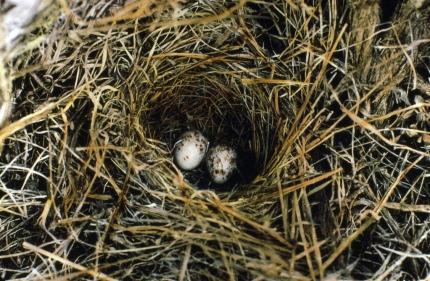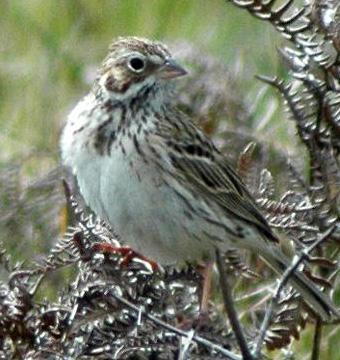Moderate
The Oregon vesper sparrow is a subspecies of vesper sparrow. It has a restricted breeding range that includes southwestern British Columbia, western Washington, western Oregon, and northwestern California. Oregon vesper sparrows are present in western Washington primarily from early April through late September, and they migrate to winter in central and southern California. Due to loss and degradation of habitat, risk of stochastic events, and disturbances during the nesting season, this subspecies is now in danger of extirpation in Washington.
Description and Range
Physical description
Vesper sparrows are a large sparrow (6 inches in length) with pale brown-streaked plumage, white outer tail feathers, rufous lesser wing coverts, and a white eye-ring. The Oregon vesper sparrow subspecies has medium grayish-brown upperparts and white underparts with a buff tinge.
Ecology and life history
Oregon vesper sparrows typically nest in dry, open landscapes, with moderately short and structurally diverse grass and forb cover with some patchy bare ground and sparsely vegetated areas. They generally avoid wet areas or sites with tall, dense herbaceous vegetation. Structural diversity of herbaceous vegetation appears to be an important factor in site selection.
A mix of bare ground and short vegetation is chosen for foraging, moderate structured vegetation for nesting, and scattered taller vegetation, including shrubs and scattered trees, is used for cover and singing perches. Fence posts, fences and other man-made structures are often used for singing perches. Prairie size also appears to be an important factor in site selection, with only large prairies currently occupied.
Adults take dust-baths in sandy forest roads, ruts in the road, and bare spots under vegetation, and seek out shade during mid-day.
Vesper sparrows eat a wide variety of insects during the breeding season supplemented with seeds during migration and winter. They primarily forage while walking on the ground but will also hop and hover to feed. Adults provide nestlings with invertebrates and rarely seeds.

Vesper sparrows build a bulky, loose, cup-like nest of grasses and rootlets on the ground in a small depression, often near the base of a grass clump, weed, or shrub. The female typically lays three to five eggs in mid-May and incubates them for 11 to 13 days. The young fledge in 7 to 12 days, and pairs commonly raise two broods per season. Vesper sparrows exhibit relatively high annual site fidelity to nesting areas and defend small territories during the breeding season.
Banding records have reported birds more than 6 years old.
Vesper sparrows migrate in flocks of 30 or fewer.
Geographic range
Vesper sparrows occupy open habitats (grassland, shrub-steppe, and agriculture) across much of central and southern North America. The Oregon vesper sparrow is the rarest of four recognized subspecies. It has a restricted breeding range that includes southwestern British Columbia, western Washington, western Oregon, and northwestern California. It is migratory and overwinters rom central California west of the Sierra Nevada Mountains to northwestern Baja California, Mexico.
Historical accounts suggest the Oregon vesper sparrow was locally uncommon to abundant in the disjunct distribution of grassland and savannah habitat in western Washington. It has experienced range-wide population declines and range contractions, and many local extirpations. In Washington, this includes 20th century extirpations from Vashon Island of the north Puget lowlands, and the Dungeness area of the Olympic Peninsula; and extirpation from San Juan Island appears likely. It is now mainly limited in Washington to remnant prairies and grasslands in Pierce and Thurston Counties, with smaller numbers on islands in the lower Columbia River and grasslands on San Juan Island; a few may still breed in eastern Clallam County and near Shelton (Mason County).
Approximately 90% of the population occurs in the south Puget lowlands, predominantly on Joint Base Lewis-McChord. The current range-wide population estimate is less than 3,000 birds with approximately 300 of those occurring in Washington.
For maps of range-wide distribution and conservation status of this species, check out NatureServe Explorer and the International Union for Conservation of Nature Redlist.
Climate vulnerability
Sensitivity to climate change
Moderate
Oregon vesper sparrow sensitivity is largely driven by their dependence on open habitats, seeds, and insects. They nest and forage on the ground in open habitats (e.g., grasslands or shrublands with patchy vegetation and some bare ground); increasing fire frequency, temperatures, and more variable precipitation may decrease habitat availability, quality and connectivity and/or alter foraging opportunities. They may have some physiological sensitivity; for example, low temperatures can undermine nestling growth by increasing thermoregulatory costs and/or decreasing insect prey availability.
Exposure to climate change
Low-
Moderate
- Temperature changes (increase or decrease)
- Changes in precipitation
- Altered fire regimes
Conservation
Conservation Threats and Actions Needed
- Invasive and other problematic species and genes
- Threat: Invasive Scot’s broom and native conifer forest succession (due to alteration of prairie fire regime).
- Action: Restore and manage degraded habitat at prairies; use prescribed fire where possible; coordinate with airport vegetation management.
- Threat: Increased predation pressure from encroaching urbanization (domestic and feral cats).
- Action: Assess impacts of predation by cats, and assess need for, and approach to, effectively address this risk factor.
- Fish and wildlife habitat loss or degradation.
- Threat: Conservation to agriculture and development. Habitat loss isolates remaining populations.
- Action: Use land acquisitions, conservation easements and landowner agreements to protect habitat.
- War, civil unrest and military exercises
- Threat: Military training exercises disturb nesting and degrades habitat
- Action: Work with Joint Base Lewis-McChord to develop management plan for known breeding habitat.
- Outreach and education
- Threat: Recreational use of prairies; vegetation management (example: mowing airports).
- Action: Public outreach/education and coordination.
- Agriculture and aquaculture side effects
- Threat: Potential herbicide and pesticide effects.
- Action: Education and outreach.
See the Climate vulnerability section above for information about the threats posed by climate change to this species.
Resources
References
Altman, B. 2011. Historical and current distribution and populations of bird species in Prairie-Oak habitats in the Pacific Northwest. Northwest Science 85:194-222.
Mlodinow, S. G. 2005. Vesper Sparrow Pooecetes gramineus. Pp 326-327 in T. R. Wahl, B. Tweit, and S. G. Mlodinow (eds.) Birds of Washington: Status and Distribution. Oregon State University Press, Corvallis, OR, USA. 436 pp.
Smith, M. R., P. W. Mattocks, Jr., and K. M. Cassidy. 1997. Breeding birds of Washington state: location data and predicted distribution. In Cassidy, K. M., C. E. Grue, M. R. Smith, and K. M. Dvornich (eds.). Washington state GAP analysis- final report. Vol. 4 Seattle Audubon Society Publications in Zoology No. 1, Seattle, Washington.


